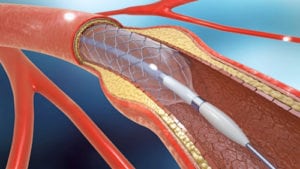Peripheral Artery Disease
At Midcoast Cardiovascular Associates, you will meet with Dr. Ginkel to discuss your concerns, as well as the condition of your heart, arteries, and veins. Many patients come in with a change in their lifestyle, mobility, or dietary habits that often have an impact on the condition of the arteries in the extremities. After a detailed conversation about your family history of any arterial and cardiovascular disease, Dr. Ginkel may suggest an ankle-brachial index (ABI) exam. The ABI provides an in-depth comparison of blood pressures in the legs and arms to confirm or rule out the diagnosis of peripheral artery disease (PAD). At Midcoast Cardiovascular, Dr. Ginkel offers PAD management through holistic methods and minimally invasive endovascular treatments of PAD.
What is PAD?
Peripheral Artery Disease, or PAD, is a progressive condition that affects the arms and legs. This condition affects over nine million people in the United States, with over 20 percent at age 60 and above. Blockages or narrowing of the arteries in upper and lower limbs can cause pain with movement and rapidly reduce the amount of oxygen available in the limbs, a condition known as ischemia. Chronic ischemia in the arms and legs can cause cell death from the lack of oxygen, since our muscles need oxygen to contract in movement. Reduced circulation in the limbs is often identified by a few symptoms, such as cold extremities a feeling of pins and needles, and a bluish color to the skin. Some patients find open sores, known as ulcers, on the skin when the condition is advanced. PAD has a few different stages that correlate with treatments and interventions offered by Dr. Ginkel.
How is PAD managed?
Peripheral artery disease can be managed with a proper regimen of a healthy diet and exercise if the condition is caught early enough. If Dr. Ginkel diagnoses you in an early stage of PAD, he will recommend that you stop smoking (if applicable) and help you implement an effective exercise plan. Every possible holistic method of treatment is combined with medications to monitor your progress. As symptoms of PAD continue to develop and blockages build without treatment, minimally invasive and surgical procedures may be necessary. These treatment options include an angioplasty procedure and endovascular stenting.
Endovascular Treatment of PAD
Again, the method of treatment for PAD depends on how developed your condition is when diagnosed using the ABI exam. In endovascular treatment, Dr. Ginkel may recommend the angioplasty or stenting implantation by inserting a catheter with a balloon. The balloon is inflated to expand the artery and allow for increased blood flow and circulation; the balloon is then removed once enough space has been created in the artery. Further intervention may require a minimally invasive stent implantation, during which the balloon leaves a stent in the artery for permanent expansion, rather than merely being used for a temporary procedure.
While stenting and angioplasty procedures do treat PAD, they are solutions for addressing the larger problem of cardiovascular disease. Dr. Ginkel works with patients to treat all lifelong conditions and monitor your progress for a healthier lifestyle. Call Midcoast Cardiovascular to find out how you can treat PAD and make a plan for your future at 805-354-0112.

Recent Comments